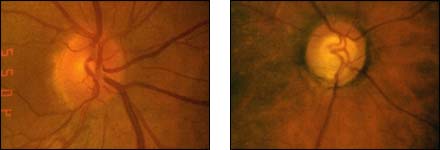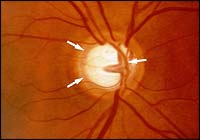Glaucoma — What is it?
Glaucoma is a disease that produces damage to the nerve in the back of the eye (optic nerve). This damage occurs because of many different factors. The pressure in the eye is usually elevated. Whether the damage to the optic nerve occurs due to high pressure or changes in blood flow to the nerve is not completely understood. We know that genetics plays some role. A specific gene for glaucoma was recently discovered which could impact treatment research for the next decade.
The pressure in the eye is usually high due to a blockage of the drainage canal inside the eye that drains fluid out of the eye. Just like when your kitchen sink drain pipe gets plugged, the pressure builds up if you leave the water running! Likewise, the pressure in the eye elevates. If nerve damage occurs, it happens over a long period of time, usually on the order of months to years. Nerve damage produces loss of side vision or peripheral vision. Progressive nerve damage produces progressive peripheral vision loss. Untreated, glaucoma is a blinding disease. There are some patients who have high pressure in the eye but their optic nerve never becomes damaged. Technically, we call that “ocular hypertension”, rather than glaucoma. Some patients with ocular hypertension are treated even though no damage has yet occurred to the optic nerve. The decision on whether to treat is based on multiple risk factors including the amount the pressure is elevated, myopia or nearsightedness, age over 40, race, and a family history of glaucoma. All of these are risk factors for glaucoma damage.

Left: Normal optic nerve. The “cup” in the middle of the nerve is the small white dot near the center. Note how small it is. The branching lines are the blood vessels. Right: Note how large and visible the central white “spot” is compared to the left photo. This is optic disc “cupping”. This is an indication of optic nerve damage which may be associated with gradual loss of peripheral vision. It usually presents without symptoms!

The arrows show the outer edge of the “cup” of the optic nerve. This nerve has glaucoma related damage. Compare this optic nerve to the normal one shown above and to the left!
There are several different types of glaucoma. The most common type is called open-angle glaucoma. There are several subcategories of this. The less common type is angle-closure glaucoma. While open-angle produces a gradual loss of peripheral vision if untreated, angle-closure can cause a sudden very high rise in pressure which can be immediately vision threatening. Immediate treatment is necessary.
Another form of glaucoma is called “Low Tension” or “Normal Pressure” glaucoma. These patients have pressures in the eye in the normal range (10-20 mm. Hg.) but they too develop nerve damage and peripheral vision loss just like the patients with high pressure. It is thought that this might occur due to a change in blood flow to the optic nerve. However, low-tension glaucoma tends be a much more aggressive form of the disease in that the peripheral vision loss tends to occur closer to the center of the vision and can change more rapidly than other forms of glaucoma.
Treatment
There is no cure for glaucoma. However, glaucoma is treatable and most patients with glaucoma do not go blind. However, just like with diabetes or high blood pressure, continuous monitoring is required to assess for any changes in the condition.
Treatment usually starts with eye drops to help lower the pressure in the eye. Some eyedrops do so by decreasing the production of fluid within the eye, much like you might do to turn down the faucet in your kitchen sink if your drain pipe became plugged. Some eye drops try to open the drainage canal inside the eye to let more fluid out. There are many different eye drops that can be used. Occasionally, pills are used to decrease the production of fluid. Laser surgery is completed in a 5 minute procedure to try to open the drainage canal inside the eye. This procedure has no pain and is successful about 80% of the time. Some types of glaucoma respond better than others. Finally, glaucoma surgery can be performed which involves surgically placing a microscopic size hole in the eye to create a new drainage canal inside the eye. This procedure is often very successful. The post-operative care and visits can be time consuming.
Evaluation
Evaluating glaucoma involves checking the pupil reactions, checking the pressure in the eye with a special instrument, evaluating the optic nerve for damage, possibly taking photographs of the nerve for use for future comparison, and formal testing of peripheral or side vision. Patients sometimes feel that no abnormality exists to their side vision when, in fact, damage is present. There are no symptoms because the damage occurs very gradually starting in the part of your vision that can compensate by overlapping peripheral visual fields from both eyes. Since no symptoms are present, many patients are only discovered to have this disease after significant damage has occurred. This is why regular eye exams are critical for patients over age 40.
Most patients with glaucoma live perfectly normal lives. While this can be a serious problem, most patient have glaucoma well controlled with either eye drops, pills, laser surgery, or standard surgery. With good medical care, there is no reason that you won’t live your life with reasonably good vision.